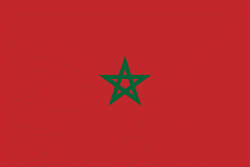Flag of Morocco
The flag of Morocco (علم المغرب) is the flag used by the government of Morocco and has served as the national flag of Morocco since 17 November 1915. The green star represents the opening and the red background represents the closure. The flag of Morocco symbolizes the opening of the country to the international.
Red has considerable historic significance in Morocco by proclaiming the descent from the royal 'Alawid dynasty. The ruling house was associated with the Islamic prophet Muhammad via Fatimah, the wife of Ali, the fourth Muslim Caliph. Red is also the colour that was used by the sharifs of Mecca and the imams of Yemen. Since the 17th century, Morocco is ruled by the 'Alawid dynasty, and the first flags of the country were plain red.
On 17 November 1915, Sultan Yusef signed a dhahir that made Morocco's flag red with a green interlaced pentangle.
While Morocco was under French and Spanish control, the red flag with the seal in the centre remained in use but only inland since its use at sea was prohibited. When independence was restored in 1955, it once again became the national flag.
The pentagram represents the Seal of Solomon, an Islamic symbol. The five branches also represent the pillars of Islam.
The legal definition of the flag specifies that the colours are bright red and palm green. No more precise colour specifications are known to be published. The RGB colours used in the illustration on the Kingdom's website are listed below, along with rough CMYK and Pantone equivalents for printing.
Red has considerable historic significance in Morocco by proclaiming the descent from the royal 'Alawid dynasty. The ruling house was associated with the Islamic prophet Muhammad via Fatimah, the wife of Ali, the fourth Muslim Caliph. Red is also the colour that was used by the sharifs of Mecca and the imams of Yemen. Since the 17th century, Morocco is ruled by the 'Alawid dynasty, and the first flags of the country were plain red.
On 17 November 1915, Sultan Yusef signed a dhahir that made Morocco's flag red with a green interlaced pentangle.
While Morocco was under French and Spanish control, the red flag with the seal in the centre remained in use but only inland since its use at sea was prohibited. When independence was restored in 1955, it once again became the national flag.
The pentagram represents the Seal of Solomon, an Islamic symbol. The five branches also represent the pillars of Islam.
The legal definition of the flag specifies that the colours are bright red and palm green. No more precise colour specifications are known to be published. The RGB colours used in the illustration on the Kingdom's website are listed below, along with rough CMYK and Pantone equivalents for printing.
National flag
Country - Morocco
Warning: getimagesize(/Image/Map/MP2542007.gif): failed to open stream: No such file or directory in /home/mapnlee7/public_html/MAPNALL/article.php on line 532
 |
 |
In a region inhabited since the Paleolithic era over 300,000 years ago, the first Moroccan state was established by Idris I in 788. It was subsequently ruled by a series of independent dynasties, reaching its zenith as a regional power in the 11th and 12th centuries, under the Almoravid and Almohad dynasties, when it controlled most of the Iberian Peninsula and the Maghreb. In the 15th and 16th centuries, Morocco faced external threats to its sovereignty, with Portugal seizing some territory and the Ottoman Empire encroaching from the east. The Marinid and Saadi dynasties otherwise resisted foreign domination, and Morocco was the only North African nation to escape Ottoman dominion. The 'Alawi dynasty, which rules the country to this day, seized power in 1631, and over the next two centuries expanded diplomatic and commercial relations with the Western world. Morocco's strategic location near the mouth of the Mediterranean drew renewed European interest; in 1912, France and Spain divided the country into respective protectorates, reserving an international zone in Tangier. Following intermittent riots and revolts against colonial rule, in 1956, Morocco regained its independence and reunified.
